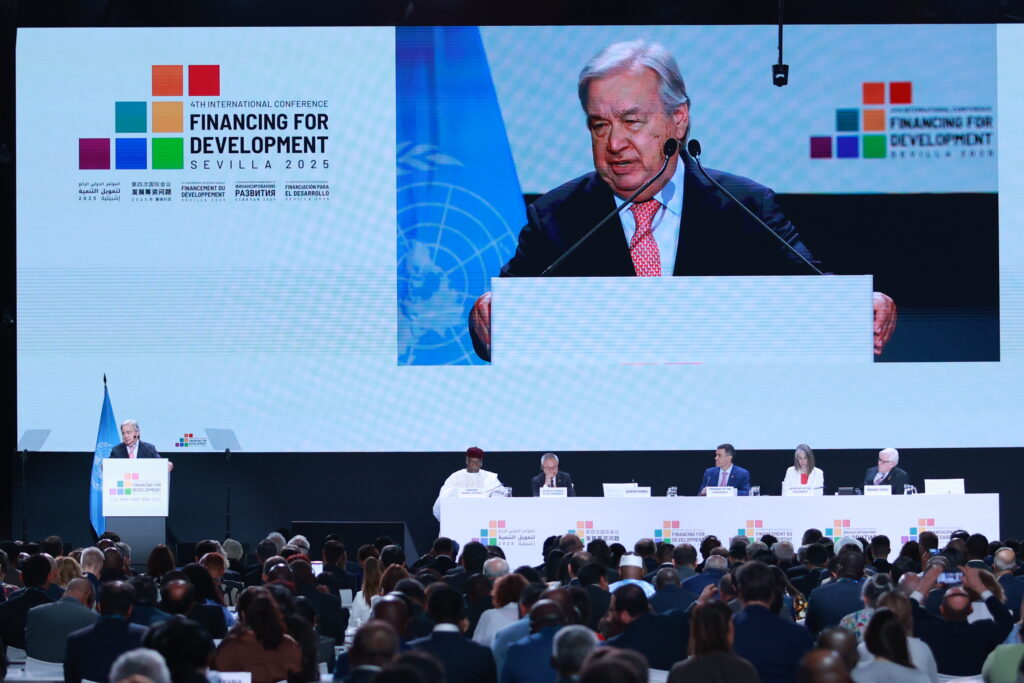Interviews / Human Security
9 July 2025
Seville 2025: international cooperation put to the test by its own contradictions

On 3 July, the fourth International Conference on Financing for Development concluded with the adoption of the “Seville Commitment”. Unanimously approved, the document provides for a strengthening of existing financing through a “renewed global framework”. Despite the ambitions it embodies, certain shortcomings are already visible, casting doubt over its effective implementation. What are the key challenges of this multilateral commitment and the objectives it pursues? Does the absence of the United States from the process significantly undermine the achievement of these goals? How is this commitment perceived by international development actors? An analysis by Fatou Élise Ba, researcher at IRIS and head of the Human Security Programme.
To what extent does the absence of the United States at the negotiating table reflect the challenges facing international cooperation in the current context?
First and foremost, international conferences on financing provide forums for dialogue in which decision-makers, international organisations, civil society actors and private sector representatives come together to mobilise collectively around major global economic and social challenges. The 4th International Conference on Financing for Development (FFD4), held in Seville, Spain, from 30 June to 3 July 2025, is part of a series of multilateral frameworks: the Monterrey Conference (2002), which first built consensus around development financing and shared responsibility between states; the Doha Conference (2008), held during the global financial crisis, which underscored the need to strengthen the stability of the international financial architecture; and the Addis Ababa Conference (2015), which established commitments to structure the Sustainable Development Goals (SDGs) by 2030. The Seville Conference, therefore, comes five years before the SDG deadline.
Historically, the United States has played a particularly proactive role in implementing international commitments at these conferences. As the world’s largest economy and a major development funder, its role is crucial in resource mobilisation. However, a major turning point at this conference was Washington’s withdrawal from the negotiation process of the “Compromiso de Sevilla” (the “Seville Commitment”), the final framework document. This withdrawal was widely interpreted as a sign of growing geopolitical fractures. On 19 June 2025, at the United Nations (UN), just prior to the Financing for Development Summit in Seville, Jonathan Shrier, the US representative to the Economic and Social Council, had nonetheless reaffirmed US commitment by declaring: “Our commitment to international cooperation and long-term economic development remains firm”. However, the United States ultimately chose the opposite path and withdrew from the process. The US administration justified this absence by expressing concern that such commitments might undermine national sovereignty and domestic economic interests. The United States’ “à la carte multilateralism” is now more relevant than ever and reflects a foreign policy orientation driven solely by domestic interests (“America First”). The UN Secretary-General, António Guterres, has expressed hope that the United States will regain a central role in supporting countries in the Global South, which are facing significant challenges. The current geopolitical uncertainty and the erosion of trust between nations, as recalled by the President of the European Council, António Costa, show that multilateralism is undergoing a period of turbulence, threatening the ability to “restart the development engine” in the face of a colossal financing gap and worsening debt conditions in the most fragile countries.
Since the beginning of the Trump II administration, there has been a concrete rollback of international aid and the development paradigm, notably with the dismantling of most of the programmes and funding of USAID, the United States Agency for International Development. The US government argues that aid does not primarily serve the interests of the United States. A relatively questionable point, given that official development assistance has proven to be an excellent instrument of soft power in times of crisis, particularly in national security matters, and in ensuring good diplomatic relations with other states—especially in regions where multiple threats are proliferating.
Ultimately, the US withdrawal contributes to the weakening of international cooperation frameworks. Strategically, it can be seen as reflecting a preference for bilateral, competitive, and transactional approaches, in a context marked by the reconfiguration of global strategic alliances. This posture weakens coordination efforts between nations in the face of cross-cutting challenges such as climate change, economic inequality or humanitarian crises that require collective responses.
With the exception of Emmanuel Macron, none of the other G7 leaders attended in person, choosing instead to send high-level delegations. This event aimed to initiate deep reflection on financing for development, particularly in the Global South. The withdrawal of the world’s leading power leaves space for new powers and suggests a Western retreat in aid, with the emergence of new donor states and private actors. The BRICS+ group has shown renewed commitments—particularly China, which has progressively established a presence in countries from which the United States has abruptly withdrawn.
As the UN Secretary-General António Guterres calls to “restart the development engine”, what are the main areas of action targeted by the “Seville Commitment”?
The desire to accelerate progress on the Sustainable Development Goals (SDGs), particularly through sufficient financing, is part of a UN plea to deliver a global response to global challenges, especially in a context of multiple crises where developing countries are facing rising debt levels. The United Nations estimates that around $4 trillion in additional investment per year would be needed (a 50% increase in development financing) to achieve the SDGs. The conference highlighted the mismatch between the current international financing architecture and the requirements of sustainable development.
In 2024, global public debt reached a record high of $102 trillion. For countries in the Global South, the cost of debt is disproportionate and restricts access to affordable financing. These countries often spend more on interest payments than on essential public policies such as health or education. And this situation could worsen in the near future. African countries are particularly affected, as they allocate more than 10% of their public resources to debt interest payments, to the detriment of their own development. The conference brought this context back to the forefront of high-level discussions. Stakeholders called for the development of crisis prevention mechanisms and improved inclusivity for low-income countries. To reduce global inequalities, one proposal in particular was put forward: to promote more effective taxation of the world’s “super-rich”, at the initiative of Spain and Brazil.
The Seville Commitment addresses global debt by proposing, among other things, alliances between countries and development banks to introduce debt suspension clauses in times of crisis, as well as strengthening domestic public resources. This roadmap aims to ease the debt burden, catalyse the necessary investment to finance development, and mobilise large companies to attract private funds. Nevertheless, it does not at this stage represent a true global restructuring of the international financial architecture. The absence of binding commitments and the lack of coordination between public and private actors severely limit the operational scope of these initiatives.
More broadly, the gradual decline in development aid, though often viewed negatively, may also present new opportunities for autonomy for low-income countries, especially in Africa. This trend forces them to break with historically dependent models. In the face of fragmented multilateral frameworks, the least developed countries now need to strengthen budgetary autonomy, promote intra-African investment and jointly develop public-private partnerships. This reorientation towards endogenous development models aligns perfectly with the objectives of the African Union’s Agenda 2063.
What do the criticisms from international development actors reveal about the limitations of this otherwise ambitious commitment? What impact might this have on their field operations?
Several non-governmental organisations (NGOs) and civil society actors have identified shortcomings in the “Seville Commitment”, particularly with regard to the lack of concrete actions. The final declaration merely reaffirms the objective of allocating 0.7% of gross national income (GNI) to official development assistance (ODA), without any clear operational commitments. This declaration stood in stark contrast to the massive recent budget cuts—the largest since 1960.
Countries such as the United Kingdom, Germany, and France have significantly reduced their contributions, under the pressure of the global debt crisis. Certain sectors are particularly at risk. UNESCO, for example, raised the alarm at the Seville conference about the decline in education funding. This support could fall by more than a quarter between 2023 and 2027, after a 12% drop in 2024, jeopardising the education of millions of children, especially in conflict zones. Oxfam also denounced the lack of ambition in the Seville Commitment, arguing that it fails to compel countries in the Global North to “assume their responsibilities in the face of the debt crisis”.
Several observers have pointed out that the Seville Commitment envisions financing that is often disconnected from reality on the ground, failing to account for actual borrowing costs or the debt crisis that hinders the most vulnerable countries. In general, without significant financing and structural reforms, field organisations will continue to face limited resources, and developing countries will remain burdened by debt. A poorly charted path, clearly, for achieving the SDGs with only five years remaining. Lastly, another major point of criticism was the limited access granted to civil society representatives during the official conference discussions, revealing a lack of inclusion.

